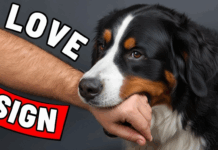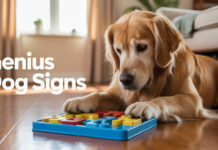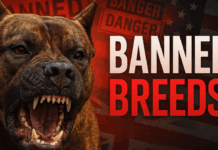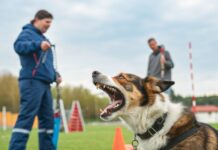Last Updated on September 3, 2024 by Dogs Vets
Our dog friends’ strange habits might leave us scratching our heads sometimes. But worry not, my fellow dog lovers!
Ever find yourself staring at your dog in its mid-grass-munching adventure and wondered, “What on earth are you thinking?” This isn’t about your dog being weird and all; it’s merely a matter of deciphering of deciphering the code of their distinct communication style.
This is going to be your Rosetta Stone to the wonderful world of Woofspeak. We’ll go beyond the common misconception that “tail wags mean happy” and investigate unusual behaviors, ranging from the (ahem) fascinating to the genuinely funny, and we’ll also uncover some genuinely strange canine oddities that science is still trying to figure out.
By the time this is over, you’ll be liken to someone fresh off from dog training academy, equipped to interpret each twitch, lick, and zoomie into a message of love, enthusiasm, or perhaps just a bad case of the zoomies. Dog lovers, fasten your seatbelts because we’re going on an amazing journey through the glorious weirdness of dog behavior!
The Classics, Reexamined
Let’s take some common behaviors and give them a tasty twist.
- The Tail Wag: As we all know, a happy tail usually wags. Did you realize, though, that the wag’s direction and speed reveal an entirely other story? A tail lifted high and wagging stiffly can hint at dominance, while a tail tucked between the legs and moving cautiously suggests fear. A leisurely, relaxed body wag might indicate modest interest, while a quick, full-body wag yells, “Let’s play!”
- Ears Perked Up: Generally speaking, having pointed ears indicates alertness and interest. However, did you know that some breeds, like as Basset Hounds, have floppy ears by nature? Be not deceived though because even with these floppy ears, it may even slightly perk up when it detects an intriguing sound.
- The Play Bow: A charming canine invitation to play is the butt-in-the-air, front paws down position. But did you know that some dogs greet playing with a play growl as well? It’s a vocalization that sounds more fun than angry, and it’s frequently accompanied by bouncing motions and a wagging tail.
Beyond the Basics: Decoding the Strange and Wonderful
Now, let’s get into the truly fascinating stuff!
- The Zoomies: We’ve all witnessed the sudden, inexplicable burst of energy that sends our dogs careening around the house like furry missiles. This phenomenon, known as “Frenetic Random Activity Periods” (FRAPs), is thought to be a way for dogs to release pent-up energy or express excitement. Think of it as their way of doing doggy jumping jacks!
- The Leg Lift: This isn’t just about marking territory, though that’s certainly part of it. Lifting a leg higher can also be a sign of dominance or confidence.
- The Head Tilt: That adorable head tilt with those big, soulful eyes? It’s not just a ploy to melt your heart (although it does a darn good job of that). Scientists believe it may be a way for dogs to focus on visual or auditory cues, especially when they’re trying to understand a human command or decipher a new sound.
- Talking in Their Sleep: Ever hear your dog whimpering, barking, or twitching their paws while snoozing? They’re probably dreaming! Just like humans, dogs experience REM sleep, which is when dreams occur. So next time you catch your pup acting out their dreams, don’t wake them up – let them chase that virtual squirrel in peace!
- Why They Eat Grass: There are a few theories about this one. Some experts believe dogs eat grass to soothe an upset stomach, while others think they might be trying to fulfill a dietary need for fiber. It could even be an instinctive behavior leftover from their wild ancestors, who ate grass to help purge parasites.
The Unexplained: Canine Mysteries Science is Still Trying to Solve
- Why They Like Rolling in Stinky Stuff: Ah, the joys of a dog returning from a walk smelling like a skunk convention. While some theories suggest they roll in stinky things to mask their own scent from predators, there’s no definitive answer. Maybe they just like the way it smells (to them, at least)?
Why They Stare: A direct stare can sometimes feel like a challenge from a dog, but it doesn’t always mean they’re gearing up for a fight. It could be a sign of affection, trying to get your attention, or simply trying to figure out what you’re doing. If the stare is accompanied by stiff body language and growling, however, then yeah, that’s a warning sign.
- Sudden Fear of Stairs: Some dogs, especially puppies, develop a sudden fear of stairs seemingly out of nowhere. This could be due to a negative experience on the stairs, like slipping or falling. Be patient and offer positive reinforcement with treats or praise as they slowly overcome their apprehension.
- Why They Bury Things: This one seems like an instinctual throwback to their wild ancestors who would bury food to save it for later. But some dogs bury their favorite toys or treats even when they have plenty of food available. Maybe they’re just playing a game of doggy hide-and-seek, or maybe they’re creating their own personal treasure trove. For example, if you’ve ever wondered if can dogs have pretzels, a dog might try to bury one just as they would with other treats, even though pretzels aren’t the healthiest option for them.
- The Contagious Yawn: Have you ever yawned and then, like magic, your dog yawns too? Science doesn’t fully understand this phenomenon, but some theories suggest it’s a sign of empathy or stress relief. Maybe they’re yawning because they’re actually tired, or maybe they’re just mirroring your behavior to strengthen the social bond.
Communication Beyond Words: It’s All in the Body Language
Remember, communication for dogs is a multi-sensory experience. Don’t just focus on the barks and whines – their body language speaks volumes!
- Relaxed Body Posture: A loose, wiggly body with a wagging tail is a universal sign of canine contentment. Pay attention to how soft their muscles are and how droopy their ears might be.
- The Tense Tuck: A tucked tail, flattened ears, and a tense body scream fear or anxiety. If your dog exhibits this posture, identify the source of their stress and try to remove them from the situation.
- Whale Eye: This isn’t a greeting card kind of expression. If your dog shows the whites of their eyes while keeping their head turned away, it’s a sign of discomfort or appeasement. Proceed with caution and avoid making any sudden movements.
- The Play Bow: We mentioned this one earlier, but it deserves another mention because it’s such a clear invitation to fun! Look for the play bow with a wagging tail and those irresistible puppy-dog eyes.
- The Sniff: Sniffing is a dog’s primary way of gathering information about the world around them. They sniff other dogs to learn about their social status, sniff lampposts to pick up neighborhood news, and yes, they sniff your crotch because that area releases pheromones that tell them all about you (don’t worry, it’s not a romantic gesture!).
Putting It All Together: Building a Stronger Bond with Your Pup (Continued)
We previously discussed some key points for understanding your dog’s communication. Here are some additional tips:
19. Respectful Greetings: When meeting a new dog, allow them to sniff each other properly. This is their way of introducing themselves and exchanging information. Avoid forcing a face-to-face interaction, as this can be overwhelming for some dogs.
20. The “Crazy Eyes”: Ever notice your dog staring at you with wide, dilated eyes and a goofy grin? This isn’t a sign of aggression, but rather a display of excitement and anticipation. They might be waiting for their favorite toy, hoping for a walk, or simply brimming with doggy happiness.
21. The Sigh of Contentment: That deep, relaxed sigh your dog lets out after a good belly rub or playtime isn’t a sign of boredom. It’s actually a doggy sigh of pure contentment!
22. Calming Signals: Did you know dogs have calming signals they use to de-escalate tense situations or avoid conflict? These can include yawning, licking their lips, averting eye contact, or lowering their body posture. According a professional board and train experts in NYC, understanding these signals can help you prevent misunderstandings and create a more peaceful environment for your pup.
23. The Playful Bite: Puppies often nip or nibble during play. While this might seem like aggression, it’s usually just a playful behavior. However, it’s important to set boundaries early on to prevent them from developing a bad habit.
24. Panting: While panting can be a sign of overheating, it can also indicate stress, anxiety, or excitement. Pay attention to the context and your dog’s overall body language to determine the cause of the panting.
25. Leaning In: If your dog leans into you, it’s not just because they’re looking for a cuddle (although that’s part of it!). Leashing in can also be a sign of affection, trust, or a request for attention.
26. Bringing You “Gifts”: That random squeaky toy or stray sock your dog proudly presents to you isn’t just playful mischief. It can be a sign of affection, a way to appease you, or an invitation to play.
27. The “Scooby Doo” Howl: While howling is often associated with wolves, some dogs also howl. This can be a way of communicating with other dogs, expressing excitement, or even alleviating boredom.
28. The Chattering Teeth: Some small dog breeds, like Chihuahuas, exhibit a rapid chattering of their teeth with a furrowed brow. This can be a sign of fear, anxiety, or frustration.
29. Sniffing Butts: Yes, this one might be a little gross to us, but for dogs, sniffing another dog’s rear end is a perfectly normal way of gathering information. They can learn about a dog’s sex, health, and even mood through these olfactory clues.
30. Drinking from the Toilet: Let’s face it, some dog behaviors are just plain puzzling. While there’s no single answer to why some dogs drink from the toilet, it could be due to boredom, a preference for cooler water, or even a urinary tract infection (so consult a vet if this becomes a regular habit).
31. Following You Everywhere: If your dog seems to be attached to your hip, take it as a compliment! This constant shadowing is a sign of their deep affection and trust in you.
32. The Playful “Shoulder Lean”: Does your dog like to lean their entire body weight against you? This playful behavior can be a sign of affection or a request for attention.
33. Ears Forward, Focused Stare: When your dog has their ears perked forward and their gaze intently fixed on something, they’re likely alert and focused on what’s happening around them.
34. The Happy Dance: That excited wiggling and bouncing your dog does when you get home or when it’s playtime is a canine celebration! It’s their way of expressing pure, unadulterated joy.
35. The Cuddle Puddle: There’s nothing quite like a good dog cuddle session. Curling up next to you on the couch is their way of showing affection, seeking comfort, or simply enjoying your company. It’s a heartwarming display of the deep bond you share.
Bonus! Because who can resist even more fascinating dog quirks?
- Dreaming with Twitches: We mentioned dogs dream, but did you know they might also twitch their paws, whimper, or even bark while snoozing? It’s all part of that dream world, and generally nothing to worry about.
- Talking to Themselves: Ever hear your dog muttering, whining, or sighing to themselves? While it might sound like they’re having a full-blown conversation, it’s likely vocalizations related to boredom, frustration, or contentment.
- Sudden Zoomies After Meals: The post-dinner zoomies are a real phenomenon! This burst of energy after eating could be a leftover instinct from their wild ancestors who would run around to burn off energy after a big meal.
- Hiding Under the Bed During Storms: Many dogs dislike thunderstorms. The loud booms and flashes of lightning can be scary for them. Providing a safe space, like a crate under the bed, can help them feel more secure during these stressful times.
- Recognizing Your Voice: Studies show dogs can differentiate between human voices and even recognize the voices of their favorite people. So, next time you talk to your pup, know they’re likely listening intently!
By understanding these diverse communication methods, you can unlock a deeper level of connection with your furry companion. Remember, patience, consistency, and a healthy dose of humor go a long way in navigating the wonderful world of Woofspeak. So, embrace the weird, celebrate the happy dances, and enjoy the journey of learning your dog’s unique language! After all, a strong communication bond is the foundation of a happy and fulfilling relationship between you and your canine best friend.

















